不要怂,就是GAN (生成式对抗网络) (四):训练和测试 GAN
在 /home/your_name/TensorFlow/DCGAN/ 下新建文件 train.py,同时新建文件夹 logs 和文件夹 samples,前者用来保存训练过程中的日志和模型,后者用来保存训练过程中采样器的采样图片,在 train.py 中输入如下代码:
# -*- coding: utf-8 -*-
import tensorflow as tf
import os from read_data import *
from utils import *
from ops import *
from model import *
from model import BATCH_SIZE def train(): # 设置 global_step ,用来记录训练过程中的 step
global_step = tf.Variable(0, name = 'global_step', trainable = False)
# 训练过程中的日志保存文件
train_dir = '/home/your_name/TensorFlow/DCGAN/logs' # 放置三个 placeholder,y 表示约束条件,images 表示送入判别器的图片,
# z 表示随机噪声
y= tf.placeholder(tf.float32, [BATCH_SIZE, 10], name='y')
images = tf.placeholder(tf.float32, [64, 28, 28, 1], name='real_images')
z = tf.placeholder(tf.float32, [None, 100], name='z') # 由生成器生成图像 G
G = generator(z, y)
# 真实图像送入判别器
D, D_logits = discriminator(images, y)
# 采样器采样图像
samples = sampler(z, y)
# 生成图像送入判别器
D_, D_logits_ = discriminator(G, y, reuse = True) # 损失计算
d_loss_real = tf.reduce_mean(
tf.nn.sigmoid_cross_entropy_with_logits(D_logits, tf.ones_like(D)))
d_loss_fake = tf.reduce_mean(
tf.nn.sigmoid_cross_entropy_with_logits(D_logits_, tf.zeros_like(D_)))
d_loss = d_loss_real + d_loss_fake
g_loss = tf.reduce_mean(
tf.nn.sigmoid_cross_entropy_with_logits(D_logits_, tf.ones_like(D_))) # 总结操作
z_sum = tf.histogram_summary("z", z)
d_sum = tf.histogram_summary("d", D)
d__sum = tf.histogram_summary("d_", D_)
G_sum = tf.image_summary("G", G) d_loss_real_sum = tf.scalar_summary("d_loss_real", d_loss_real)
d_loss_fake_sum = tf.scalar_summary("d_loss_fake", d_loss_fake)
d_loss_sum = tf.scalar_summary("d_loss", d_loss)
g_loss_sum = tf.scalar_summary("g_loss", g_loss) # 合并各自的总结
g_sum = tf.merge_summary([z_sum, d__sum, G_sum, d_loss_fake_sum, g_loss_sum])
d_sum = tf.merge_summary([z_sum, d_sum, d_loss_real_sum, d_loss_sum]) # 生成器和判别器要更新的变量,用于 tf.train.Optimizer 的 var_list
t_vars = tf.trainable_variables()
d_vars = [var for var in t_vars if 'd_' in var.name]
g_vars = [var for var in t_vars if 'g_' in var.name] saver = tf.train.Saver() # 优化算法采用 Adam
d_optim = tf.train.AdamOptimizer(0.0002, beta1 = 0.5) \
.minimize(d_loss, var_list = d_vars, global_step = global_step)
g_optim = tf.train.AdamOptimizer(0.0002, beta1 = 0.5) \
.minimize(g_loss, var_list = g_vars, global_step = global_step) os.environ['CUDA_VISIBLE_DEVICES'] = str(0)
config = tf.ConfigProto()
config.gpu_options.per_process_gpu_memory_fraction = 0.2
sess = tf.InteractiveSession(config=config) init = tf.initialize_all_variables()
writer = tf.train.SummaryWriter(train_dir, sess.graph) # 这个自己理解吧
data_x, data_y = read_data()
sample_z = np.random.uniform(-1, 1, size=(BATCH_SIZE, 100))
# sample_images = data_x[0: 64]
sample_labels = data_y[0: 64]
sess.run(init) # 循环 25 个 epoch 训练网络
for epoch in range(25):
batch_idxs = 1093
for idx in range(batch_idxs):
batch_images = data_x[idx*64: (idx+1)*64]
batch_labels = data_y[idx*64: (idx+1)*64]
batch_z = np.random.uniform(-1, 1, size=(BATCH_SIZE, 100)) # 更新 D 的参数
_, summary_str = sess.run([d_optim, d_sum],
feed_dict = {images: batch_images,
z: batch_z,
y: batch_labels})
writer.add_summary(summary_str, idx+1) # 更新 G 的参数
_, summary_str = sess.run([g_optim, g_sum],
feed_dict = {z: batch_z,
y: batch_labels})
writer.add_summary(summary_str, idx+1) # 更新两次 G 的参数确保网络的稳定
_, summary_str = sess.run([g_optim, g_sum],
feed_dict = {z: batch_z,
y: batch_labels})
writer.add_summary(summary_str, idx+1) # 计算训练过程中的损失,打印出来
errD_fake = d_loss_fake.eval({z: batch_z, y: batch_labels})
errD_real = d_loss_real.eval({images: batch_images, y: batch_labels})
errG = g_loss.eval({z: batch_z, y: batch_labels}) if idx % 20 == 0:
print("Epoch: [%2d] [%4d/%4d] d_loss: %.8f, g_loss: %.8f" \
% (epoch, idx, batch_idxs, errD_fake+errD_real, errG)) # 训练过程中,用采样器采样,并且保存采样的图片到
# /home/your_name/TensorFlow/DCGAN/samples/
if idx % 100 == 1:
sample = sess.run(samples, feed_dict = {z: sample_z, y: sample_labels})
samples_path = '/home/your_name/TensorFlow/DCGAN/samples/'
save_images(sample, [8, 8],
samples_path + 'test_%d_epoch_%d.png' % (epoch, idx))
print 'save down' # 每过 500 次迭代,保存一次模型
if idx % 500 == 2:
checkpoint_path = os.path.join(train_dir, 'DCGAN_model.ckpt')
saver.save(sess, checkpoint_path, global_step = idx+1) sess.close() if __name__ == '__main__':
train()
输入完成后点击运行,运行过程中,可以看到,生成的每个图片对应行对应列都是一样的数字,这是因为我们加了条件约束;采样器 sampler 采样的图片被保存在 samples 文件夹下,由模糊到清晰,由刚开始的噪声,慢慢变成手写字符,最后完全区分不出来是生成图片还是真实图片,反正我是区分不出来,you can you up。

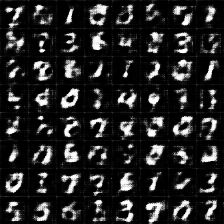
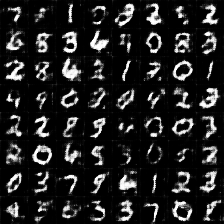


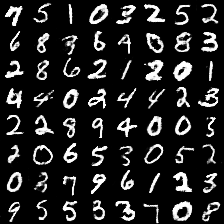
与此同时,要是在训练的时候打开 TensorBoard,可以看到 D 的分布,大致在趋于 0.5 左右的附件徘徊,说明判别器 D 已经趋于判别不出来了,只能随机猜测,正确率大致 0.5。
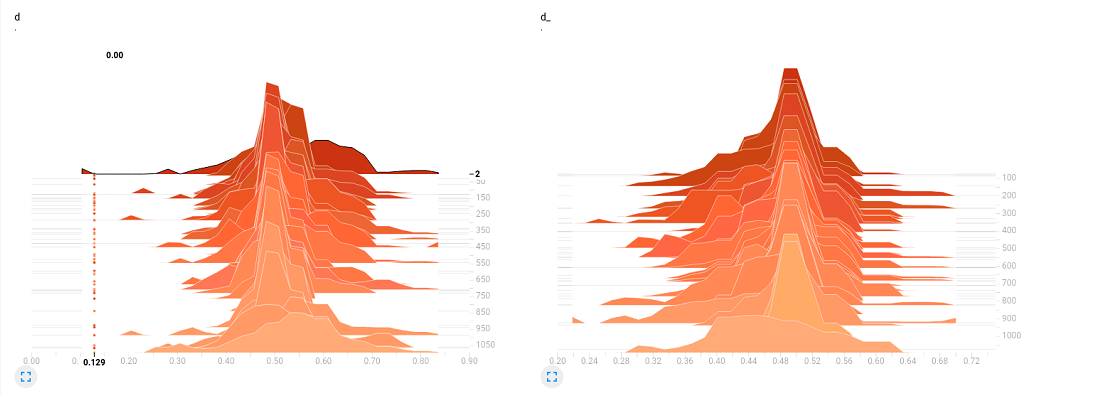
讲道理,我们的 GAN 到这一步,已经算是完成了,测试的过程,我们已经在训练的时候通过采样完成了,如果嫌不够,非要单独写个测试的文件,也不是不可以:
在 /home/your_name/TensorFlow/DCGAN/ 下新建文件 eval.py 和文件夹 eval,eval 文件夹用来保存测试结果图片,在 eval.py 中输入如下代码:
# -*- coding: utf-8 -*-
import tensorflow as tf
import os from read_data import *
from utils import *
from ops import *
from model import *
from model import BATCH_SIZE def eval():
# 用于存放测试图片
test_dir = '/home/your_name/TensorFlow/DCGAN/eval/'
# 从此处加载模型
checkpoint_dir = '/home/your_name/TensorFlow/DCGAN/logs/' y= tf.placeholder(tf.float32, [BATCH_SIZE, 10], name='y')
z = tf.placeholder(tf.float32, [None, 100], name='z') G = generator(z, y)
data_x, data_y = read_data()
sample_z = np.random.uniform(-1, 1, size=(BATCH_SIZE, 100))
sample_labels = data_y[120: 184] # 读取 ckpt 需要 sess,saver
print("Reading checkpoints...")
ckpt = tf.train.get_checkpoint_state(checkpoint_dir) # saver
saver = tf.train.Saver(tf.all_variables()) # sess
os.environ['CUDA_VISIBLE_DEVICES'] = str(0)
config = tf.ConfigProto()
config.gpu_options.per_process_gpu_memory_fraction = 0.2
sess = tf.InteractiveSession(config=config) # 从保存的模型中恢复变量
if ckpt and ckpt.model_checkpoint_path:
ckpt_name = os.path.basename(ckpt.model_checkpoint_path)
saver.restore(sess, os.path.join(checkpoint_dir, ckpt_name)) # 用恢复的变量进行生成器的测试
test_sess = sess.run(G, feed_dict = {z: sample_z, y: sample_labels}) # 保存测试的生成器图片到特定文件夹
save_images(test_sess, [8, 8], test_dir + 'test_%d.png' % 500) sess.close() if __name__ == '__main__': eval()
点击运行,在 eval 文件夹下生成test_500.png 文件,可以看到,生成器 G 已经可以生成不错的结果。
训练测试完,可以打开 TensorBoard 查看网络的 Graph,可以看到,由于没有细致采用 namespace 和 variable_scope ,画出来的 Graph 比较凌乱,只能依稀的看出来网络的一些结构。
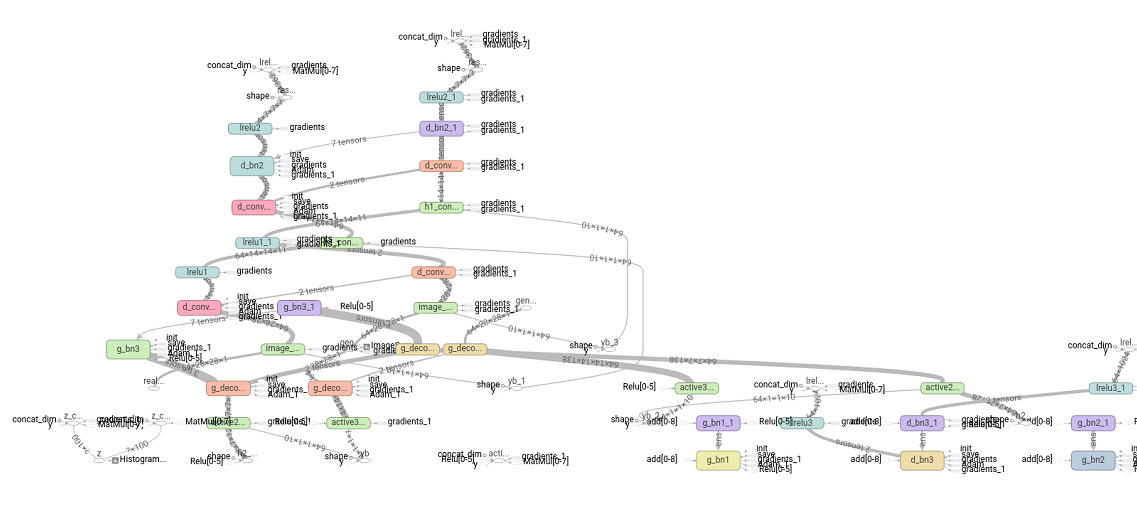
至此,我们的 TensorFlow GAN 工作基本完成,细心的朋友会发现,我们的程序存在以下几个问题:
1)在写 eval() 函数的时候,对于生成函数 generator(),没有指定 train = False,也就是在 BN 层,没有体现出训练和测试的区别;
2)在我的这篇 http://www.cnblogs.com/Charles-Wan/p/6197019.html 博客中,提到了我采用了 tfrecords 进行 GAN 数据的输入处理,但是此程序并没有体现出来;
3)没有细致的采用 namespace 和 variable_scope ,画出来的 Graph 比较凌乱;
4)程序中太多不明含义的数字,路径名字全都采用绝对路径;
5)训练过程中不能断点续训练等。
针对以上问题,我们在下一节的不加约束 GAN 上将进行改进。
参考文献:
1. https://github.com/carpedm20/DCGAN-tensorflow
不要怂,就是GAN (生成式对抗网络) (四):训练和测试 GAN的更多相关文章
- 不要怂,就是GAN (生成式对抗网络) (一): GAN 简介
前面我们用 TensorFlow 写了简单的 cifar10 分类的代码,得到还不错的结果,下面我们来研究一下生成式对抗网络 GAN,并且用 TensorFlow 代码实现. 自从 Ian Goodf ...
- GAN生成式对抗网络(四)——SRGAN超高分辨率图片重构
论文pdf 地址:https://arxiv.org/pdf/1609.04802v1.pdf 我的实际效果 清晰度距离我的期待有距离. 颜色上面存在差距. 解决想法 增加一个颜色判别器.将颜色值反馈 ...
- GAN生成式对抗网络(三)——mnist数据生成
通过GAN生成式对抗网络,产生mnist数据 引入包,数据约定等 import numpy as np import matplotlib.pyplot as plt import input_dat ...
- GAN生成式对抗网络(一)——原理
生成式对抗网络(GAN, Generative Adversarial Networks )是一种深度学习模型 GAN包括两个核心模块. 1.生成器模块 --generator 2.判别器模块--de ...
- 不要怂,就是GAN (生成式对抗网络) (一)
前面我们用 TensorFlow 写了简单的 cifar10 分类的代码,得到还不错的结果,下面我们来研究一下生成式对抗网络 GAN,并且用 TensorFlow 代码实现. 自从 Ian Goodf ...
- 不要怂,就是GAN (生成式对抗网络) (二)
前面我们了解了 GAN 的原理,下面我们就来用 TensorFlow 搭建 GAN(严格说来是 DCGAN,如无特别说明,本系列文章所说的 GAN 均指 DCGAN),如前面所说,GAN 分为有约束条 ...
- 不要怂,就是GAN (生成式对抗网络) (二):数据读取和操作
前面我们了解了 GAN 的原理,下面我们就来用 TensorFlow 搭建 GAN(严格说来是 DCGAN,如无特别说明,本系列文章所说的 GAN 均指 DCGAN),如前面所说,GAN 分为有约束条 ...
- 不要怂,就是GAN (生成式对抗网络) (六):Wasserstein GAN(WGAN) TensorFlow 代码
先来梳理一下我们之前所写的代码,原始的生成对抗网络,所要优化的目标函数为: 此目标函数可以分为两部分来看: ①固定生成器 G,优化判别器 D, 则上式可以写成如下形式: 可以转化为最小化形式: 我们编 ...
- 不要怂,就是GAN (生成式对抗网络) (五):无约束条件的 GAN 代码与网络的 Graph
GAN 这个领域发展太快,日新月异,各种 GAN 层出不穷,前几天看到一篇关于 Wasserstein GAN 的文章,讲的很好,在此把它分享出来一起学习:https://zhuanlan.zhihu ...
随机推荐
- ruby, gem install 出现网络错误
gem sources #查看目前的源 gem sources --remove https://rubygems.org/ gem sources -a https://ruby.taobao.or ...
- Java——异常谜题
1.谜题36 try和finally语句,代码如下,判断输出 public class Indecisive { public static void main(String[] args) { S ...
- Spring整合Hibernate--声明式事务管理
Spring指定datasource 1. 新建jdbc.properties文件: jdbc.driverClassName=com.mysql.jdbc.Driver jdbc.url=jdbc: ...
- Hibernate---基础配置
hibernate.cfg.xml里可以设置一个值显示更详细的sql语句: <property name="format_sql">true</property& ...
- UVA 11551 Experienced Endeavour
矩阵快速幂. 题意事实上已经告诉我们这是一个矩阵乘法的运算过程. 构造矩阵:把xi列的bij都标为1. 例如样例二: #include<cstdio> #include<cstrin ...
- iOS开发——导入第三方库引起的unknown type name 'NSString'
今天加入SVProgressHUD的第三方库的时候报了24个错误( too many errors emitted, stopping now),都是 expected identifier or ' ...
- 【转】程序员必须知道的几个Git代码托管平台
一.VS2013中克隆远程Git仓库和SSH的配置 1.VS2013中克隆远程项目 首先感谢园友的评论和补充,今日又仔细看了一下,VS2013中是可以克隆项目的,只是我一直用的GitHub来克隆的 ...
- STM32——timer
原文地址: http://blog.sina.com.cn/s/blog_49cb42490100s6ud.html 1. STM32的Timer简介 STM32中一共有11个定时器,其中 ...
- JQueryUI确认框 confirm
$(function(){ $('#AlertMsg').dialog({ autoOpen: false, width: 300, modal: true, position: 'center', ...
- gulp学习指南之CSS合并、压缩与MD5命名及路径替换
1.引入插件 var gulp = require('gulp'), // uglify = require('gulp-uglify'), concat = require('gulp-concat ...
